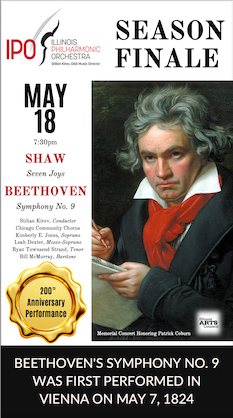Violinist Tashiro’s Piazzolla outing highlights a mixed IPO program

Following up a dazzling start to its season, the Illinois Philharmonic Orchestra, led by music director Stilian Kirov, offered a more subdued if equally intriguing program Saturday night in Palos Heights at Trinity Christian College’s Ozinga Chapel. On the bill: a bit of Piazzolla, a Mozart lodestar, and, to kick things off, a world premiere by a rising-star composer.
Oswald Huỳnh is the IPO’s composer in residence for the 2023-24 season, the latest milestone in the composer’s impressive upward trajectory. (In 2024, Huỳnh will relocate to Louisville to assume the role of Creator-in-Residence at the Louisville Orchestra). The Portland, Oregon–based composer has been celebrated for his evocative, textured ensemble scores that plumb themes of cultural heritage and identity.
Huỳnh’s program note describes Then, as if breathing, the sea swelled beneath us—the title borrows a line by Vietnamese- American poet Ocean Vuong — as a “contemplation of family traditions, dynamics of intergenerational relationships, and the barriers of communication between eras.” Cast in three movements, the piece explores the ideas through a literary lens.
The first movement, “Uống nước nhớ nguồn,” opens with a daring feature for solo cello, which was delivered with soulfulness and breathless lyricism by principal cellist Jacob Hanegan. As the cello line yields, a subtly iridescent cloud of harmonics bloom and ripple like pools of mercury.
A slinky, sinuous violin duet in canonic delayed effect launches “But birds, as you say, fly forward.” As other voices in the orchestra take up the echoed melody, the rest of the ensemble billows with gentle waves of whispered sound punctuated by col legno snaps.
Huỳnh’s gift for crafting compelling melodies and conjuring timbral atmosphere is evident in Then, as if breathing, but at times the work’s nebulous sense of form—coupled with a loose interpretive hand on Kirov’s part—left latter swaths of the first and second movements with a sense of aimlessness.
The finale, “I will learn to love a monster” offers a corrective to this problem thanks to a repeated passacaglia-like structure anchored by a lithe cello line. This ostinato provides a backbone for the other effects to unfold before morphing from a repeated line into a sumptuous cello cadenza that structurally mirrors the drama of the movement’s opening.
Illinois Philharmonic concertmaster Azusa Tashiro was the soloist for Astor Piazzolla’s wry, charismatic Four Seasons of Buenos Aires, which proved a high point of the evening. Tashiro married earnest feeling with schmaltz and vigor throughout, but absolutely soared in the expansive lyricism that marked “Invierno Porteño.” Kudos are again due to principal cello Jacob Hanegan, whose fine solo work in “Otoño Porteño” finely complemented Tashiro’s tense and searching recitation of the movement’s cadenza.
The lean string-orchestra configuration provided limber and balanced support led by Kirov’s skillful hand. The conductor drew a gauzy sound bolstered by bright tempo in the opening “Verano Porteño,” and in “Primavera Porteña,” after a patchy start, Kirov imbued a jolt of rhythmic resolve before the rest of the orchestra rejoined for the snappy tango.
Tempo changes indeed proved a challenge throughout the evening, however; an ill-coordinated downshift toward the end of “Otoño” settled into a tempo that, while not enough to hamper the technical performance, expelled some of the life from the movement.
After intermission, a fleet of wind players supplanted the strings for Mozart’s Gran Partita, a hardly obscure work that has nonetheless received some memorable Chicago performances in recent seasons. In contrast to the savory first aperitifs of the program’s first half, however, the main course was on balance largely wanting for bold flavors.
A clumsy entrance marked an inauspicious start to the opening Largo, which was saddled with a bassy, bottom-heavy sonority. The ensemble sound was further weighed down by doughy articulation in the winds that kept the movement from taking flight even in the Allegro molto section.
That ballast better served the regal second-movement Minuetto, underscoring the contrasts between tutti and soli moments. Of these, the first Trio shined brightest thanks to a particularly delicate and nuanced showing by the orchestra’s wonderful clarinet section.
Kirov brought a lighter touch that opened up the sound of the Adagio, imbuing it with an understated solemnity despite the movement’s beatific associations. Throughout the partita, the orchestra’s featured principals — particularly oboist Naomi Bensdorf Frisch and clarinetist Claire Werling — delivered solos with eloquence, grace, and uniform purity of sound.
By contrast, Kirov minimized his gestures to turn his musicians loose in the freewheeling Rondo; they tore through the principal theme with a spirited, even manic energy, giving a much-needed lift to close the program.
The Illinois Philharmonic Orchestra’s season continues December 9 at 3 p.m. with a program of holiday music featuring the Chicago Community Chorus. ipomusic.org
Posted in Performances





